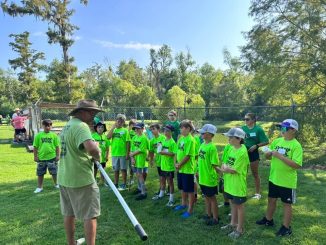
By LSU AgCenter Horticulturists Dan Gill, Kyle Huffstickler and Allen Owings
Ground covers are very popular landscape plants in Louisiana. The percentage of all ornamental plants sold in the state in the ground cover category is much higher than in other southern states.
Our most common ground cover is liriope. This plant has several species. The three main liriope species grown in the southeastern United States are L. muscari (clumping), L. gigantean (giant) and L. spicata (spreading). You may see liriope also sold by the common name border grass. Industry pros and home gardeners commonly say you should never have to buy new liriope – just get extra plants from your neighbors!
Do not confuse liriope with monkey grass. These are separate plants belonging to different plant genera.
Although liriope is a great plant and vigorous grower when given good conditions, occasional problems arise with landscape use. Growers, landscapers and home gardeners have long wanted improvements over existing varieties in terms of growth habit, uniformity in sun and shade performance, and winter aesthetics. (Many liriope “lay flat” in the landscape during the winter. This is not desirable.)
Big Blue liriope, or some form of it, is the main variety you find at garden centers. In most cases, you commonly see liriope just sold at the garden center as either green or variegated. Green liriope is usually best suited for sun while variegated liriope is usually best suited for shade. People who develop new varieties are trying to find ones with more disease resistance.
Anthracnose, which causes spotting and browning of leaf blades, is commonly observed in winter and is also a problem in late summer and fall after periods of heavy rainfall or over-irrigation. Crown rot of liriope, which leads to root death and a yellowing of leaf blades in the crown of the plant canopy, has also become an ever-growing problem in the past five years. Anthracnose can be controlled with fungicide applications, but the root/crown rot is hard to control once the disease is established.
Wholesale nurseries have released many new liriope and mondo grass varieties over the past 5-10 years. Most of these have not been evaluated under landscape growing conditions in the southeastern United States.
New liriope varieties to try that are improvements over the industry standards are Marc Anthony, Emerald Goddess and Super Blue. These are more available for landscape professionals than they are home gardeners.
To get the best out of liriope in a landscape situation, select the best-performing varieties. Also, be sure to match your sun/shade situation with the variety being planted and make sure landscape beds are well drained and raised. Liriope are fairly drought tolerant, so be sure not to over-irrigate. It is a good idea, especially on older plantings, to prune liriope in late winter prior to new leaf growth – generally from early to late February in Louisiana, depending on where you live.
Fertilize liriope annually in the spring with a slow-release landscape fertilizer. After plantings are 5-6 years old, thin them, especially in borders, once every three years to maintain vigor. You can provide your neighbors many new plants or have plants for other locations in your landscape.




Be the first to comment